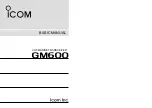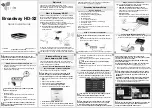System Considerations
MC1321x Reference Manual, Rev. 1.6
Freescale Semiconductor
3-33
3.12.6.1.2
Modem RX Timing profile
The receive or RX timing profile is very similar to the CCA profile.
for an RX operation. There is the initial 144
μ
s warm-up period from idle current to full RX current
(typically 37 mA) followed by the RX operation (RX is covered in detail in
The RX time is not a set figure as it is in a CCA operation. In some applications (typically not battery
operated) such as a Coordinator, the receiver can be turned on for a majority of the timer listening for End
Devices or Routers. In an End Device (typically battery operated), the receiver can be typically turned on
only when expecting an acknowledgement (ACK) of a transmission. The worst case RX on time can be
when no ACK is received and the RX operation times out with not having received a frame.
The RX operation will end based on receiving the end of a frame or being terminated by the application
having timed-out and aborted the RX operation. The return to Idle happens very quickly.
Figure 3-11. RX Timing Profile
3.12.6.1.3
Modem TX Timing profile
The transmit or TX timing profile is more predictable than the RX profile.
shows the timing
profile for a TX operation. There is the usual initial 144
μ
s warm-up period from idle current to full TX
current (typically 30 mA) followed by the TX operation (TX is covered in detail in
). The TX time is not a set figure but it is predictable.
The raw transmission rate of the
802.15.4 2.4 GHz physical layer is 62.5 ksymbols/s or 250 kb/s. This
means the TX time for 2 symbols or 1 byte of data is 32
μ
s. An
802.15.4 2.4 Standard compliant packet
has 4 bytes of preamble, 1 byte of SFD, 1 byte of FLI, 2 bytes of FCS plus the payload data (125 bytes
maximum). As a result the, the overhead of a frame is 8 bytes or 8 x 32 = 256
μ
s, and the maximum payload
TX time is 125 x 32 = 4000
μ
s. The TX time for a packet then is:
Total TX time (
μ
s) = 256 + (payload bytes x 32)
The TX operation will end after the FCS bytes are sent. The return to Idle has a “warm down” period of
10
μ
s to allow the RF transmitter to taper off in a manner to avoid RF “splatter”.
Figure 3-12. TX Timing Profile
W armup
Idle
RX
S tate:
Idle
144
μ
s
W arm up
Idle
TX
S ta te:
Idle
144
μ
s
10
μ
s
W arm d own
Содержание freescale semiconductor MC13211
Страница 40: ...MC1321x Pins and Connections MC1321x Reference Manual Rev 1 6 2 6 Freescale Semiconductor...
Страница 100: ...MC1321x Serial Peripheral Interface SPI MC1321x Reference Manual Rev 1 6 4 24 Freescale Semiconductor...
Страница 166: ...Modem Modes of Operation MC1321x Reference Manual Rev 1 6 7 22 Freescale Semiconductor...
Страница 172: ...Modem Interrupt Description MC1321x Reference Manual Rev 1 6 8 6 Freescale Semiconductor...
Страница 186: ...MCU Modes of Operation MC1321x Reference Manual Rev 1 6 10 8 Freescale Semiconductor...
Страница 208: ...MCU Memory MC1321x Reference Manual Rev 1 6 11 22 Freescale Semiconductor...
Страница 244: ...MCU Parallel Input Output MC1321x Reference Manual Rev 1 6 13 20 Freescale Semiconductor...
Страница 288: ...MCU Central Processor Unit CPU MC1321x Reference Manual Rev 1 6 15 20 Freescale Semiconductor...
Страница 308: ...MCU Timer PWM TPM Module MC1321x Reference Manual Rev 1 6 17 16 Freescale Semiconductor...
Страница 338: ...Inter Integrated Circuit IIC MC1321x Reference Manual Rev 1 6 19 14 Freescale Semiconductor...
Страница 372: ...Development Support MC1321x Reference Manual Rev 1 6 21 20 Freescale Semiconductor...


















